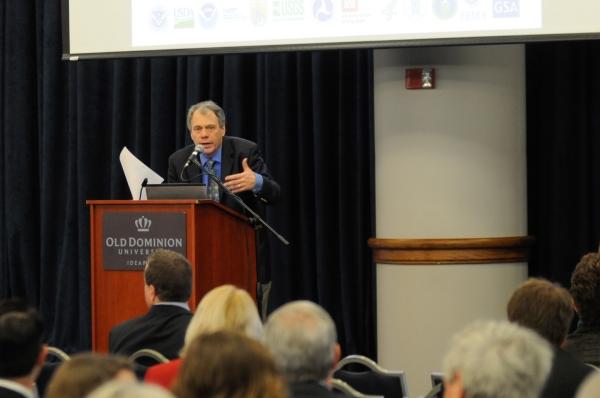ODU Hosts FEMA Listening Session on New Flood Protection Standards
March 11, 2015
 Ray Toll addresses the crowd during the FEMA listening session at Old Dominion University.
Ray Toll addresses the crowd during the FEMA listening session at Old Dominion University.
Old Dominion University played host Wednesday to one of a handful of "listening sessions" the Federal Emergency Management Association (FEMA) is using to gather information from the public about implementation of the new Federal Flood Risk Management Standard (FFRMS).
In the March 11 session, one of six scheduled nationally, FEMA officials heard from citizens and affected groups about the new flood protection standards that were established Jan. 30 through an executive order by President Barack Obama.
The FEMA event further solidifies a growing partnership between the federal government and ODU in developing substantive approaches to addressing threats to public and personal property presented by sea level rise.
A hub of related research, the University was tasked by the White House in 2014 with leading a pilot project aimed at developing a "whole of government" and "whole of community" approach to sea level rise preparedness and resilience planning in Hampton Roads that is intended to be used as a template for other regions and countries faced with similar challenges.
Ray Toll, Old Dominion University's director of coastal resiliency research, introduced the session and remarked that 18 different federal agencies are involved in the complex task of mitigating the effects of rising seas.
"FEMA has been a key partner for us in the whole of government approach we are taking to combat sea level rise and work on solutions," he said.
Michael Grimm, director of the risk reduction division with FEMA's Federal Insurance and Mitigation Administration, told the audience FEMA officials were eager to hear specific, detailed suggestions for how the FFRMS should be implemented.
Grimm noted that since 1980, flooding has caused $260 billion in damage to U.S. property, has comprised 85 percent of all disaster declarations and resulted in more deaths than any other natural hazard.
The Standard seeks to offer greater protection in flood-affected areas by mandating a greater level of flood protection for any infrastructure project that will receive federal funds.
Grimm said communities and states have already acted to ensure structures and facilities are built further from flood-affected areas.
"It's time for the federal government to catch up, frankly. So that's what this effort is for," he said.
Participants in the listening program were invited to take part in four different breakout sessions, discussing topics such as climate science data; flood elevation and floodplain standards; ecosystem and nature-based approaches; and critical actions.
FEMA officials also heard from individuals with concerns ranging from how the standard would affect homebuilders, to assistance available for people already living in flood-prone areas.
Following the nationwide listening sessions, the FFRMS implementation guidelines will be made publicly available April 6. Federal agencies then have 30 days to produce their own departmental implementation plans.
Prior to the listening session, Old Dominion University played host March 10 to a public hearing on the Commonwealth of Virginia's application for a National Disaster Resiliency Competition grant through the U.S. Department of Housing and Urban Development (HUD).
Toll said active participation in that meeting, as well as robust attendance at Wednesday's FEMA event demonstrates that both the federal and state governments are "recognizing the potential of what this region can do to tackle this critical issue."
Brian J. Moran, Secretary of Public Safety and Homeland Security for the Commonwealth of Virginia, attended the FEMA listening session, as well as Tuesday night's public hearing.
"I'm encouraged by the citizen engagement and awareness of this issue. At both meetings, we had significant public input," Moran said. "For us to successfully tackle this issue, we are going to need buy-in from the affected communities, and the public."
President Obama's executive order, "Establishing a Federal Flood Risk Management Standard and a Process for Further Soliciting and Considering Stakeholder Input." mandates that future federal investments in, and affecting floodplains, will be required to meet the level of resilience established in the Federal Flood Risk Management Standard. This includes projects where federal funds are used to build new structures and facilities, or to rebuild those that have been damaged. These requirements ensure buildings are constructed to withstand the impacts of flooding, improve the resilience of communities and protect federal investments.
For more information on the FFRMS and listening sessions, visit the FEMA website.

